Energy-Efficient and Robust QoS Control for Wireless Sensor Networks Using the Extended Gur Game †
Abstract
1. Introduction
1.1. Related Works
1.2. Our Work
- Innovative QoS control mechanisms: We propose an extended Gur game, featuring sensor node rotation, a proactive referee, and unambiguous reward/punishment mechanisms, specifically designed for energy-efficient and robust QoS control in WSNs.
- Theoretical advancement: We prove that the proposed extension resolves the M/2 convergence issue, an open problem in the original Gur game model.
- Real-world implementation: Unlike earlier studies confined to algorithm-level discussions, we implement the extended Gur game on a real WSN platform using TinyOS and nesC, validating its practicality and effectiveness through real-world deployment.
- Enhanced performance evaluations: Extensive evaluations using realistic network emulations and system-level simulations provide high-fidelity performance insights, demonstrating significant improvements in QoS and energy efficiency.
- Robustness under node mobility: Additional evaluations under dynamic node mobility highlight our approach’s robustness and its applicability in challenging, real-world scenarios.
2. Background
3. The Extended Gur Game
3.1. Player Rotation
3.2. A Proactive Referee
3.3. Unambiguous Reward/Punishment
3.4. Robust Gur Game for QoS Control in WSNs
4. Performance Evaluations
4.1. Development Environments and Simulation Tools
4.2. Simulation Setup
4.3. Performance Metrics
4.4. The Evaluation of the Standard Gur Game
4.5. The Evaluation of Shuffle
4.6. The Evaluation of the Extended Gur Game
4.7. Performance Comparison and Analysis
5. Energy Efficiency
6. Conclusions and Future Work
Author Contributions
Funding
Data Availability Statement
Conflicts of Interest
Appendix A
- (a)
- If at epoch we have , then let . In this case, only the nodes who voted yes in the robust Gur game will change their state, s.t.
- (b)
- If at epoch we have , then let . As we know, in this case only the node who voted no will change their state, s.t.
- (c)
- From (a) and (b), we learn that if , when increases, always decreases. Now we consider the case when , we know now .
References
- Kim, S.; Pakzad, S.; Culler, D.; Demmel, J.; Fenves, G.; Glaser, S.; Turon, M. Health monitoring of civil infrastructures using wireless sensor networks. In Proceedings of the 6th International Conference on Information Processing in Sensor Networks, ISPN, Cambridge, MA, USA, 25–27 April 2007; pp. 254–263. [Google Scholar]
- Navarro, M.; Davis, T.W.; Villalba, G.; Li, Y.; Zhong, X.; Erratt, N.; Liang, X.; Liang, Y. Towards Long-Term Multi-Hop WSN Deployments for Environmental Monitoring: An Experimental Network Evaluation. J. Sens. Actuator Netw. 2014, 3, 297–330. [Google Scholar] [CrossRef]
- Paek, J.; Chintalapudi, K.; Cafferey, J.; Govindan, R.; Masri, S. A wireless sensor network for structural health monitoring: Performance and experience. In Proceedings of the Second IEEE Workshop on Embedded Networked Sensors, EmNets, Sydney, Australia, 31 May 2005; pp. 1–9. [Google Scholar]
- Werner-Allen, G.; Lorincz, K.; Johnson, J.; Lees, J.; Welsh, M. Fidelity and yield in a volcano monitoring sensor network. In Proceedings of the 7th Symposium on Operating Systems Design and Implementation, OSDI, Seattle, WA, USA, 6–8 November 2006; pp. 381–396. [Google Scholar]
- Iyer, R.; Kleinrock, L. QoS control for sensor networks. In Proceedings of the IEEE International Conference on Communications, Anchorage, AK, USA, 11–15 May 2003; pp. 517–521. [Google Scholar]
- Tsetlin, M.L. Linear Automaton Theory and Modeling of Biological Systems; Academic: New York, NY, USA, 1973. [Google Scholar]
- Tung, B.; Kleinrock, L. Using finite state automata to produce self-optimization and self-control. IEEE Trans. Parallel Distrib. Syst. 1996, 7, 439–448. [Google Scholar] [CrossRef]
- Liu, C.; Fan, J.; Hui, P.; Crowcroft, J.; Ding, G. QoI-Aware Energy-Efficient Participatory Crowdsourcing. IEEE Sens. J. 2013, 13, 3742–3753. [Google Scholar] [CrossRef]
- Shi, H.Y.; Wang, W.L.; Kwok, N.M.; Chen, S.Y. Game theory for wireless sensor networks: A survey. Sensors 2012, 12, 9055–9097. [Google Scholar] [CrossRef] [PubMed]
- Iyer, R. Probabilistic Distributed Control. Ph.D. Dissertation, Department of Computer Science, University of California, Los Angeles, CA, USA, 2008. [Google Scholar]
- Forlik, J. QoS control for random access wireless sensor network. In Proceedings of the 2004 IEEE Wireless Communications and Networking Conference (IEEE Cat. No.04TH8733), Atlanta, GA, USA, 21–25 March 2004; pp. 1522–1527. [Google Scholar]
- Kay, J.; Frolik, J. Quality of service analysis and control for wireless sensor networks. In Proceedings of the 2004 IEEE International Conference on Mobile Ad-Hoc and Sensor Systems (IEEE Cat. No.04EX975), Ft. Lauderdale, FL, USA, 25–27 October 2004; pp. 359–368. [Google Scholar]
- Kay, J.; Frolik, J. An expedient wireless sensor automaton with system scalability and efficiency benefits. IEEE Trans. Syst. Man Cybern. Part-A 2008, 38, 1198–1209. [Google Scholar] [CrossRef]
- Ayers, M.; Liang, Y. Gureen Game: An Energy-Efficient QoS Control Scheme for Wireless Sensor Networks. In Proceedings of the Second International Green Computing Conference, Orlando, FL, USA, 25–28 July 2011. [Google Scholar]
- Wang, H.; Tsai, R. Application of periodical shuffle in controlling quality of service in wireless sensor networks. Int. J. Ad Hoc Sens. Ubiquitous Comput. 2013, 4, 17–30. [Google Scholar] [CrossRef]
- Tsai, R.G.; Lv, X.; Shen, L.; Tsai, P.H. A High-Robust Sensor Activity Control Algorithm for Wireless Sensor Networks. Sensors 2022, 22, 2020. [Google Scholar] [CrossRef] [PubMed]
- Khomami, M.M.D.; Meybodi, M.R.; Ameri, R. Cellular goore game with application to finding maximum clique in social networks. J. Comput. Des. Eng. 2022, 9, 966–991. [Google Scholar] [CrossRef]
- Jose, B.R.; Mini, S. Efficient Device Management for Enhanced Energy Utilization and Operational Performance in Internet. In Proceedings of the IEEE 8th International Conference for Convergence in Technology (I2CT), Pune, India, 7–9 April 2023. [Google Scholar]
- Hass, C.; Wilke, J.; Stohr, V. Realistic simulation of energy consumption in wireless sensor networks. In Proceedings of the 9th European Conference, EWSN 2012, Trento, Italy, 15–17 February 2012; pp. 82–97. [Google Scholar]
- Levis, P.; Madden, S.; Polastre, J.; Szewczyk, R.; Whitehouse, K.; Woo, A.; Gay, D.; Hill, J.; Welsh, M.; Brewer, E.; et al. TinyOS: An operating system for sensor networks. In Ambient Intelligence; Part 2; Springer: Berlin/Heidelberg, Germany, 2005; pp. 115–148. [Google Scholar]
- Gay, D.; Levis, P.; Behren, R.; Welsh, M.; Brewer, E.; Culler, D. The nesc language: A holistic approach to networked embedded systems. In Proceedings of the 2003 ACM SIGPLAN 2003 Conference on Programming Language Design and Implementation, San Diego, CA, USA, 9–11 June 2003; pp. 1–11. [Google Scholar]
- Amjad, M.; Sharif, M.; Afzal, M.K.; Kim, S.W. TinyOS-New Trends, Comparative Views, and Supported Sensing Applications: A Review. IEEE Sens. J. 2016, 16, 2865–2889. [Google Scholar] [CrossRef]
- Werner-Allen, G.; Swieskowski, P.; Welsh, M. MoteLab: A wireless sensor network testbed. In Proceedings of the IPSN 2005. Fourth International Symposium on Information Processing in Sensor Networks, Boise, ID, USA, 15 April 2005. [Google Scholar]
- Navarro, M.; Liang, Y.; Zhong, X. Energy-efficient and balanced routing in low-power wireless sensor networks for data collection. Ad Hoc Netw. 2022, 127, 102766. [Google Scholar] [CrossRef]
- Zhong, X.; Liang, Y. Scalable Downward Routing for Wireless Sensor Networks Actuation. IEEE Sens. J. 2019, 19, 9552–9560. [Google Scholar] [CrossRef]
- Gay, D.; Levis, P.; Culler, D. Software design patterns for tinyos. In Proceedings of the 2005 ACM SIGPLAN/SIGBED Conference on Language, Compilers, and Tools for Embedded Systems (LCTES’05), Chicago, IL, USA, 15–17 June, 2005; Volume 40, Issue 7. pp. 40–49. [Google Scholar]
- Levis, P.; Lee, N.; Welsh, M.; Culler, D. TOSSIM: Accurate and scalable simulation of entire tinyos applications. In Proceedings of the SenSys ’03: Proceedings of the 1st International Conference on Embedded Networked Sensor Systems, Los Angeles, CA, USA, 5–7 November 2003; pp. 126–137. [Google Scholar]
- Titzer, B.L.; Lee, D.K.; Palsberg, J. Avrora: Scalable sensor network simulation with precise timing. In Proceedings of the Fourth International Symposium on Information Processing in Sensor Networks, Boise, ID, USA, 15 April 2005; pp. 477–482. [Google Scholar]
- Lee, H.J.; Cerpa, A.; Levis, P. Improving wireless simulation through noise modelling. In Proceedings of the IPSN ’07: Proceedings of the 6th International Conference on Information Processing in Sensor Networks, Cambridge, MA, USA, 25–27 April 2007; pp. 21–30. [Google Scholar]
- Erratt, N.; Liang, Y. Compressed data-stream protocol: An energy-efficient compressed data-stream protocol for wireless sensor networks. IET Commun. 2011, 5, 2673–2683. [Google Scholar] [CrossRef]
- CC2420 Radio Datasheet; Texas Instruments Inc.: Dallas, TX, USA, 2013.
- IEEE Standard 802. 15.4; Wireless Medium Access Control (MAC) and Physical Layer (PHY) Specifications for Low-Rate Wireless Personal Area Networks (WPANs). IEEE Computer Society: Washington, DC, USA, 2006.



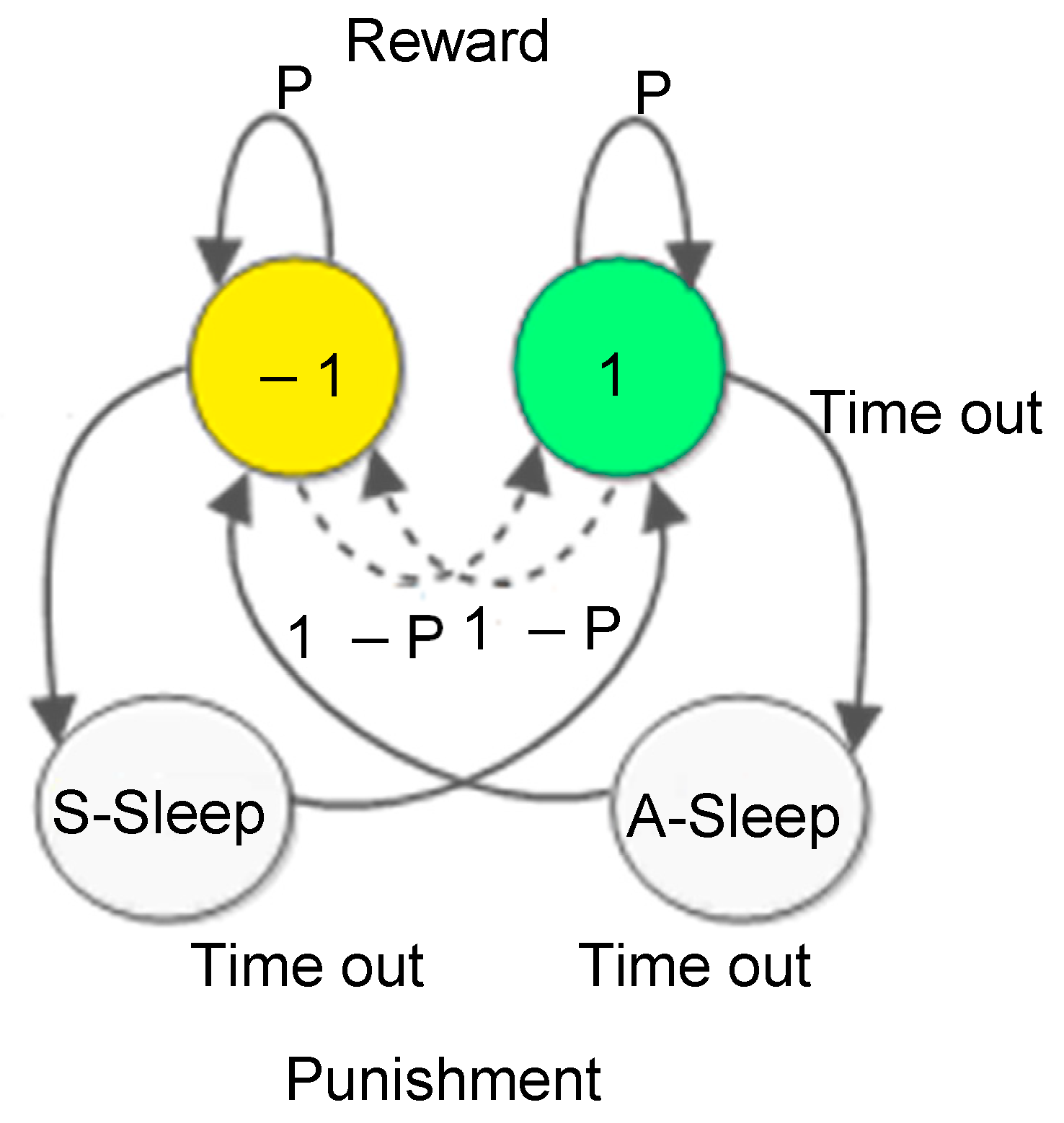
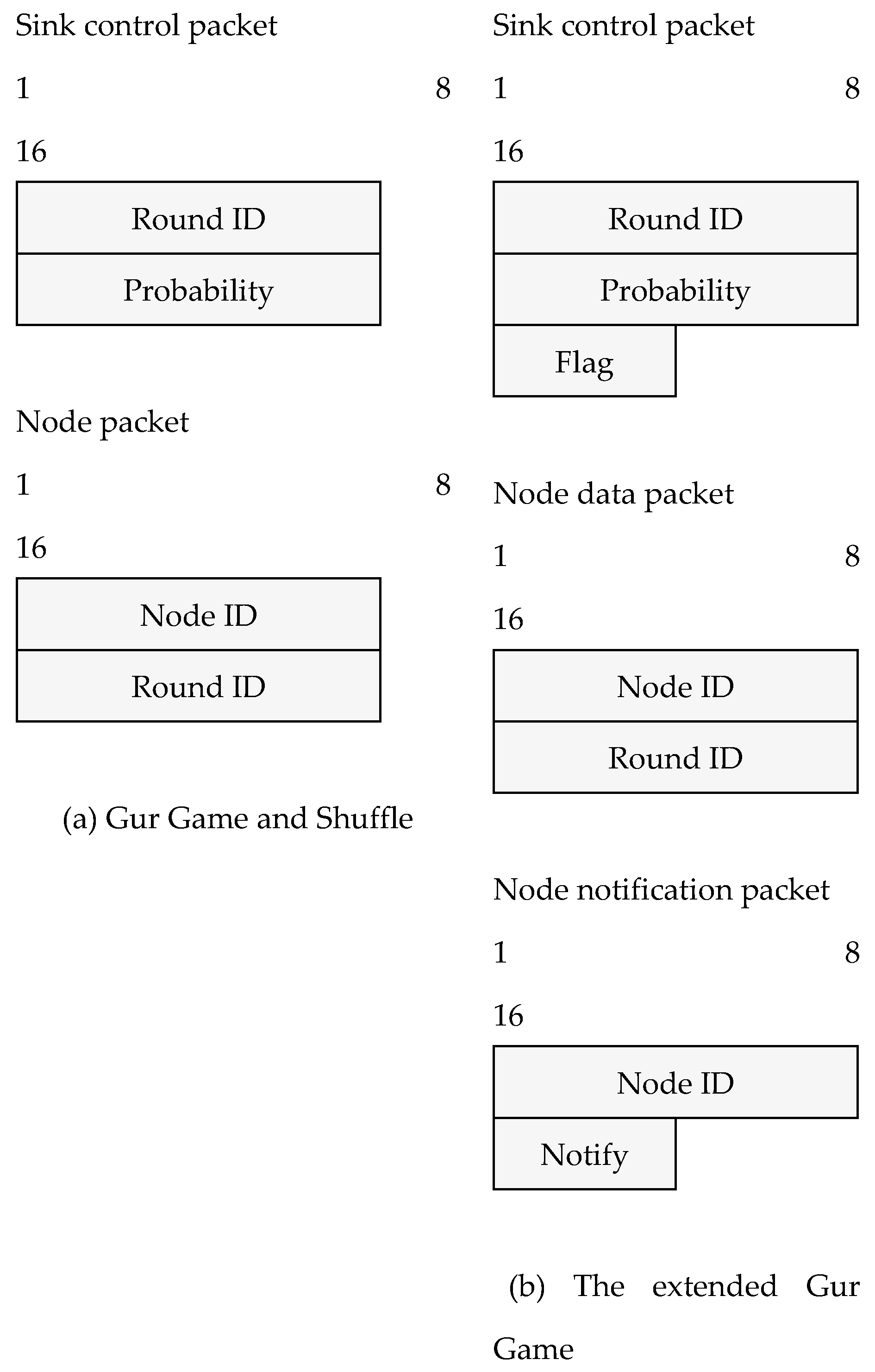

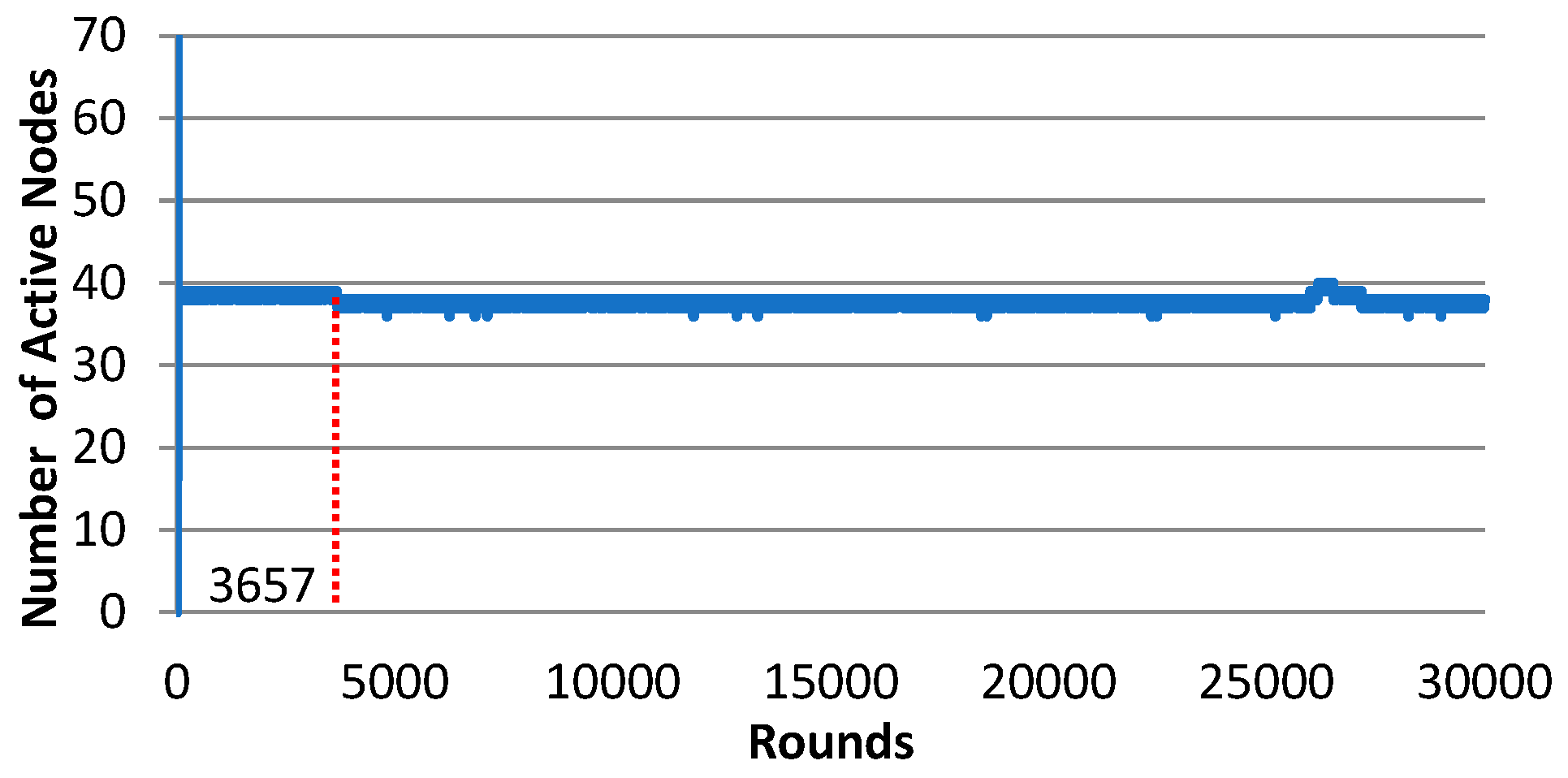
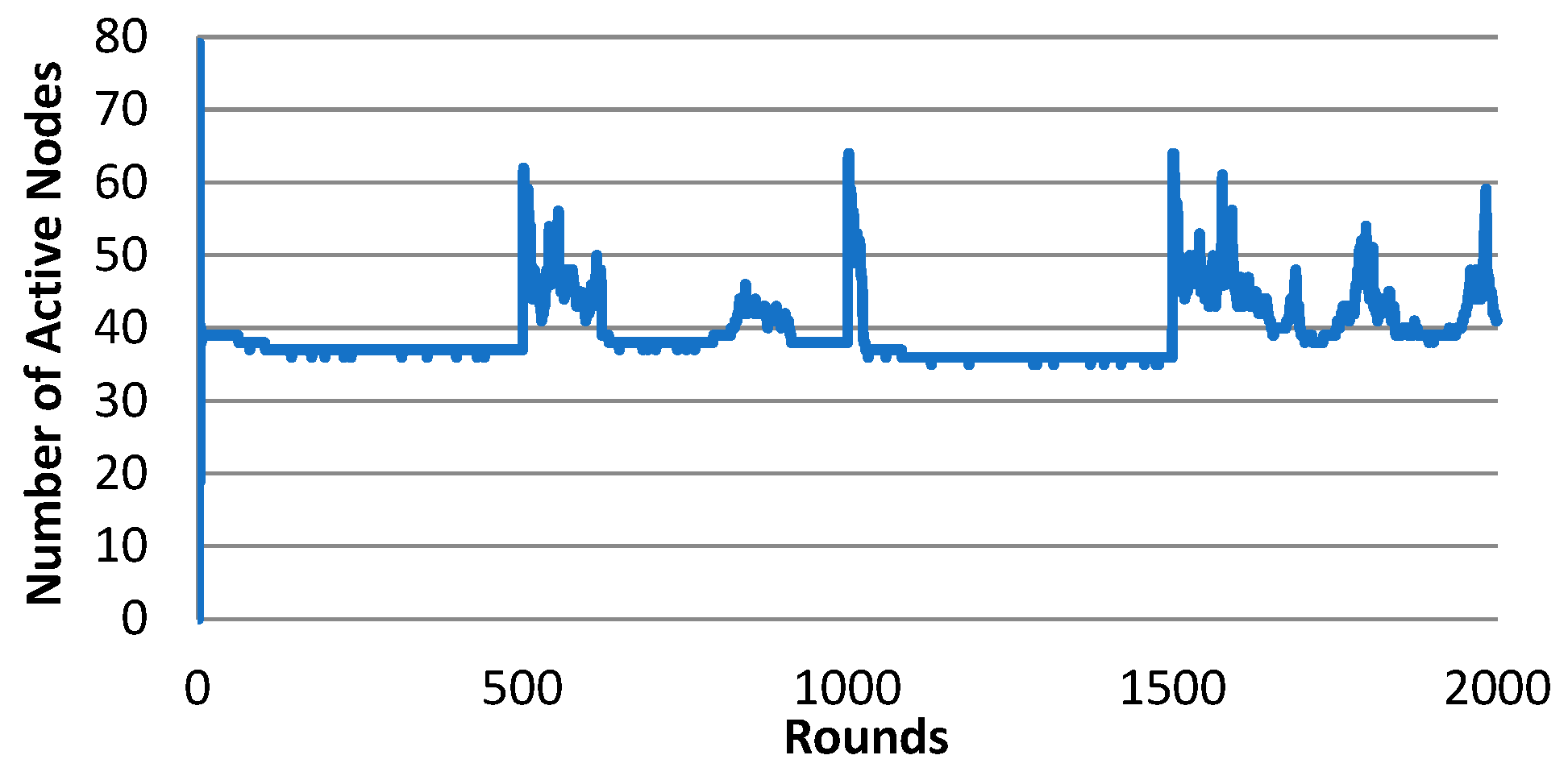

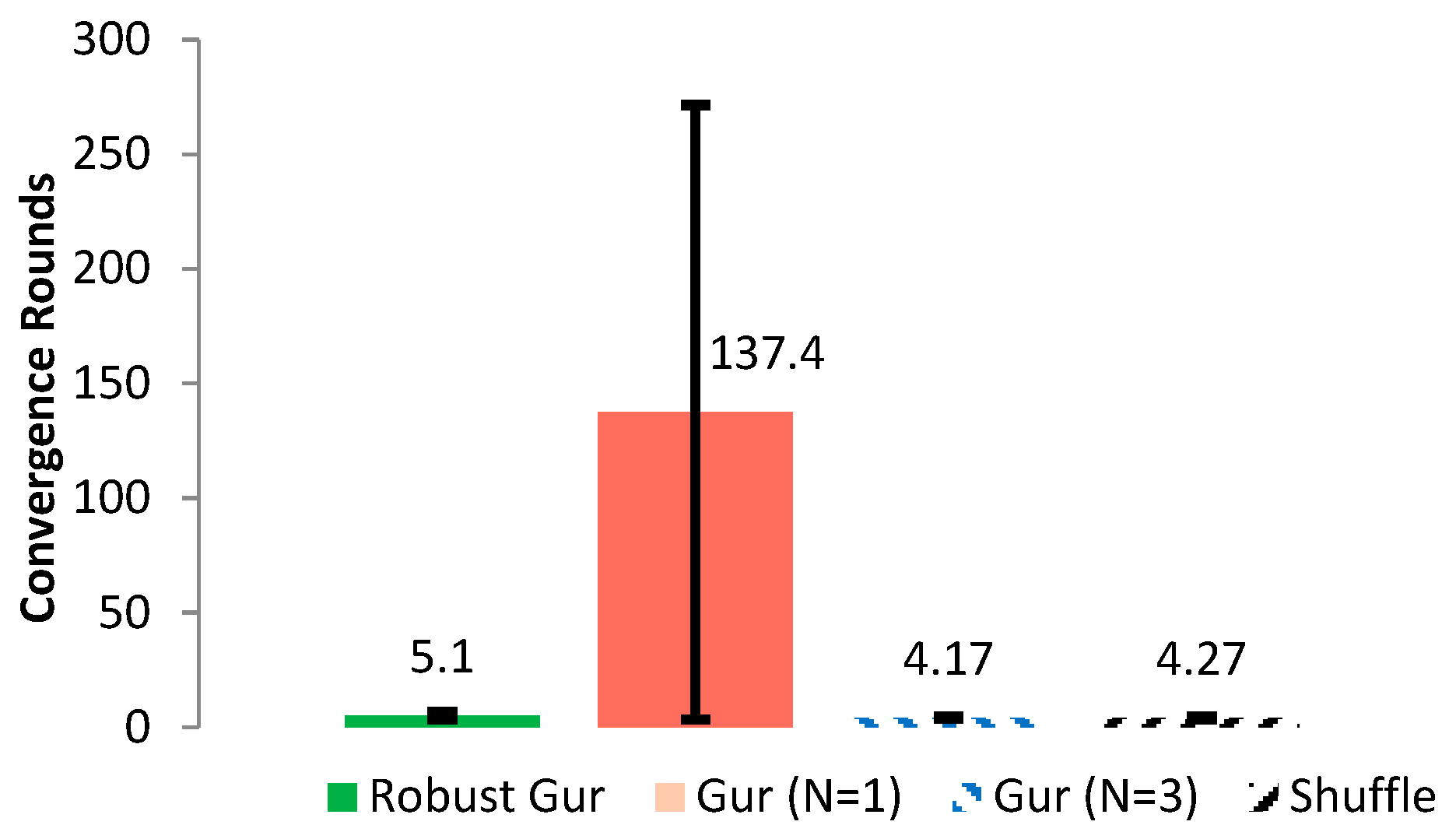
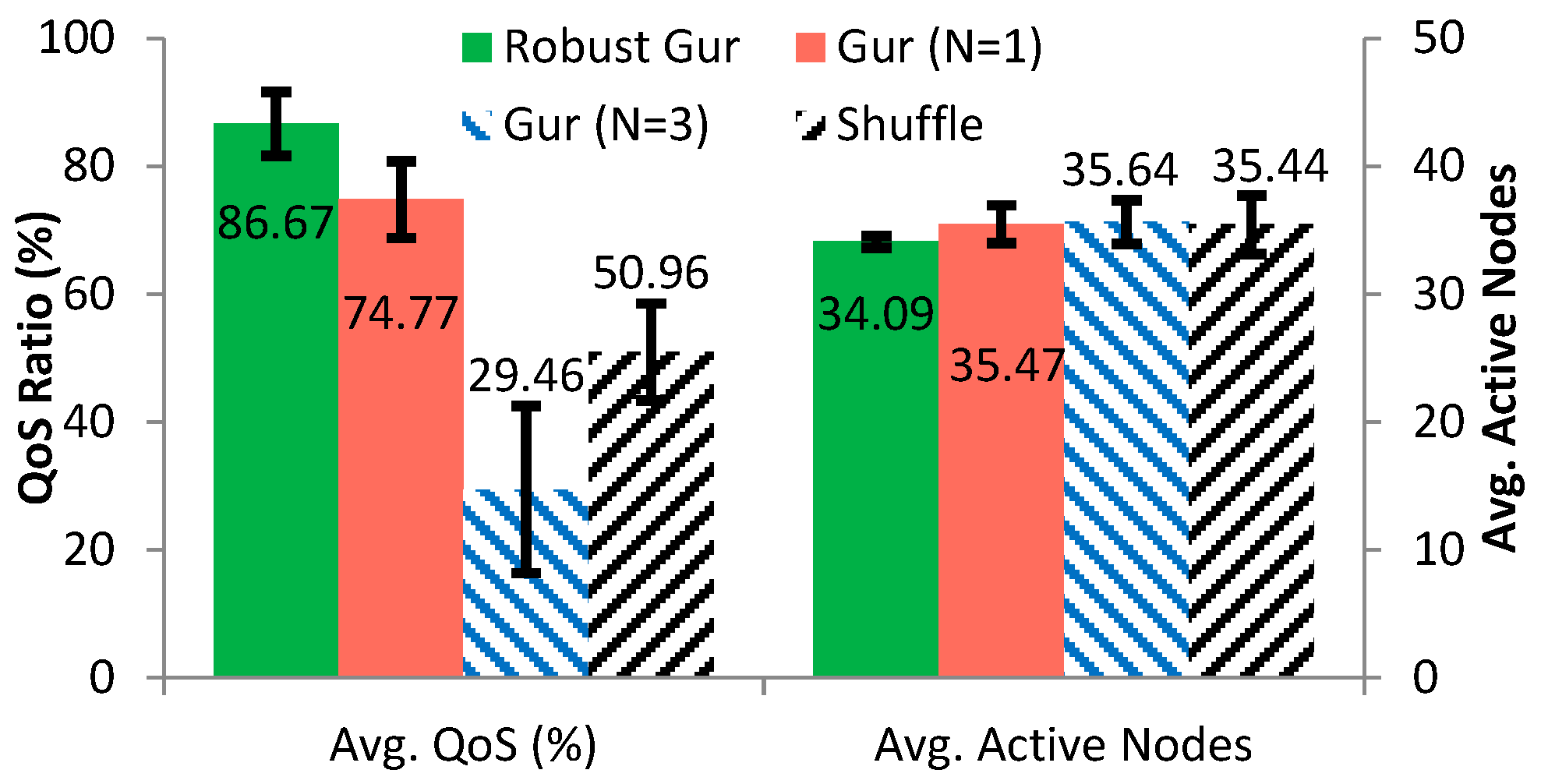
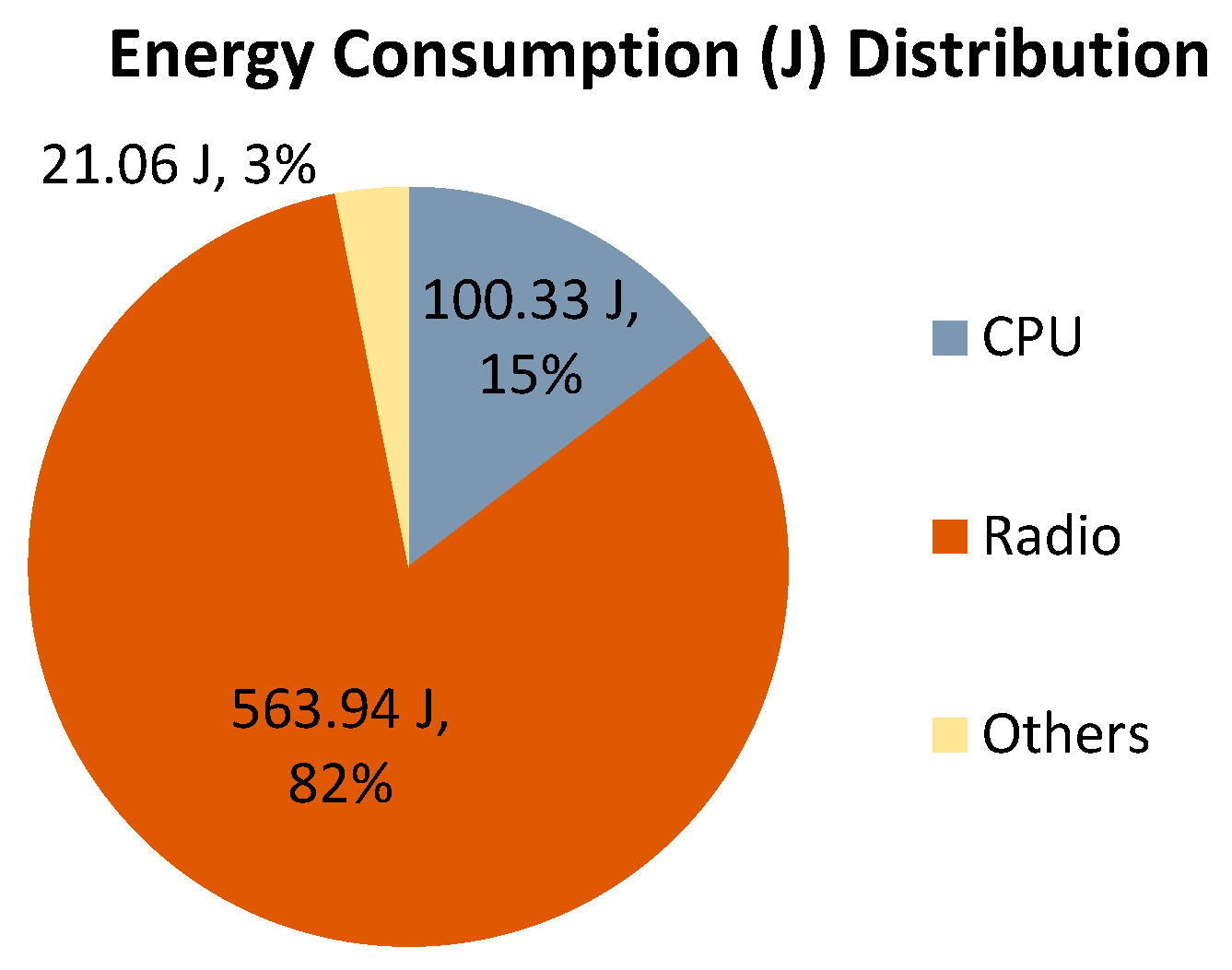

| TOSSIM | Avrora | |
|---|---|---|
| Network size | 100 | 100 |
| Optimal fraction | 0.35 | 0.35 |
| Round interval | 15 s | 15 s |
| Simulation time | 2000 rounds | 10,000 s |
| Performance Metrics | Trials | Avg. | ||||
|---|---|---|---|---|---|---|
| 1 | 2 | 3 | 4 | 5 | ||
| QoS ratio (%) | 92.90 | 72.35 | 90.15 | 64.65 | 82.55 | 80.52 |
| Active nodes (avg.) | 35.77 | 38.12 | 36.05 | 39.22 | 37.25 | 37.28 |
| Convergence time (rounds) | 163 | 362 | 129 | 543 | 13 | 242 |
| Performance Metrics | Trials | Avg. | ||||
|---|---|---|---|---|---|---|
| 1 | 2 | 3 | 4 | 5 | ||
| QoS ratio (%) | 99.80 | 99.85 | 99.85 | 0.0 | 0.03 | 59.91 |
| Active nodes (avg.) | 36.96 | 33.96 | 33.97 | 30.59 | 38.96 | 34.89 |
| Convergence time (rounds) | 4 | 3 | 3 | 3 | 4 | 3.4 |
| Performance Metrics | Trials | Avg. | ||||
|---|---|---|---|---|---|---|
| 1 | 2 | 3 | 4 | 5 | ||
| QoS ratio (%) | 49.65 | 59.15 | 45.65 | 44.00 | 18.35 | 43.46 |
| Active nodes (avg.) | 40.70 | 39.58 | 39.45 | 39.86 | 42.16 | 40.35 |
| Config. | Active Timer | Standby Timer | A-Sleep Timer | S-Sleep Timer |
|---|---|---|---|---|
| 1 | 60 | 60 | 30 | 30 |
| 2 | 60 | 60 | [1, 60] | [1, 60] |
| 3 | 60 | 60 | [1, 30] | [1, 30] |
| 4 | 30 | 60 | [1, 60] | [1, 60] |
| 5 | 30 | 60 | [1, 30] | [1, 30] |
| Config. | trials | Avg. QoS Ratio | Avg. Awake Nodes | ||||
|---|---|---|---|---|---|---|---|
| 1 | 2 | 3 | 4 | 5 | |||
| 1 | 71.35 | 68.9 | 73.55 | 70.3 | 78.05 | 72.43 | 60.95 |
| 2 | 93.70 | 91.95 | 91.90 | 93.60 | 92.10 | 92.65 | 69.36 |
| 3 | 85.95 | 86.60 | 84.75 | 85.80 | 83.85 | 85.39 | 81.98 |
| 4 | 56.80 | 54.05 | 54.65 | 53.95 | 56.55 | 55.30 | 63.77 |
| 5 | 78.50 | 76.10 | 77.30 | 76.80 | 74.55 | 76.65 | 77.31 |
| Performance Metrics | Trials | Avg. | ||||
|---|---|---|---|---|---|---|
| 1 | 2 | 3 | 4 | 5 | ||
| QoS ratio (%) | 93.7 | 91.95 | 91.9 | 93.6 | 92.1 | 92.65 |
| Active nodes (avg.) | 34.66 | 34.61 | 34.62 | 34.79 | 34.76 | 34.69 |
| Convergence time (rounds) | 5 | 5 | 4 | 4 | 5 | 4.6 |
| N | Max | Min | Std. Dev. | Avg. |
|---|---|---|---|---|
| N = 1 | 686.12 | 685.84 | 0.063 | 686.00 |
| N = 3 | 686.19 | 685.85 | 0.077 | 686.05 |
| Node | CPU | Radio | Others | Total | |
|---|---|---|---|---|---|
| Receive | Transmit | ||||
| Most active | 101.07 | 563.59 | 0.32 | 21.06 | 686.04 |
| Least active | 100.85 | 563.94 | 0.0 | 21.06 | 685.85 |
| Trials | Max | Min | Std. Dev. | Avg. | Avg. Awake Nodes Per Round |
|---|---|---|---|---|---|
| 1 | 634.27 | 389.21 | 50.52 | 509.49 | 71.05 |
| 2 | 575.40 | 432.42 | 34.49 | 495.79 | 70.93 |
| 3 | 588.92 | 407.63 | 34.85 | 490.19 | 70.00 |
| Trials avg. | 599.53 | 409.75 | 39.95 | 498.49 | 70.66 |
Disclaimer/Publisher’s Note: The statements, opinions and data contained in all publications are solely those of the individual author(s) and contributor(s) and not of MDPI and/or the editor(s). MDPI and/or the editor(s) disclaim responsibility for any injury to people or property resulting from any ideas, methods, instructions or products referred to in the content. |
© 2025 by the authors. Licensee MDPI, Basel, Switzerland. This article is an open access article distributed under the terms and conditions of the Creative Commons Attribution (CC BY) license (https://creativecommons.org/licenses/by/4.0/).
Share and Cite
Zhong, X.; Liang, Y.; Li, Y. Energy-Efficient and Robust QoS Control for Wireless Sensor Networks Using the Extended Gur Game. Sensors 2025, 25, 730. https://doi.org/10.3390/s25030730
Zhong X, Liang Y, Li Y. Energy-Efficient and Robust QoS Control for Wireless Sensor Networks Using the Extended Gur Game. Sensors. 2025; 25(3):730. https://doi.org/10.3390/s25030730
Chicago/Turabian StyleZhong, Xiaoyang, Yao Liang, and Yimei Li. 2025. "Energy-Efficient and Robust QoS Control for Wireless Sensor Networks Using the Extended Gur Game" Sensors 25, no. 3: 730. https://doi.org/10.3390/s25030730
APA StyleZhong, X., Liang, Y., & Li, Y. (2025). Energy-Efficient and Robust QoS Control for Wireless Sensor Networks Using the Extended Gur Game. Sensors, 25(3), 730. https://doi.org/10.3390/s25030730





